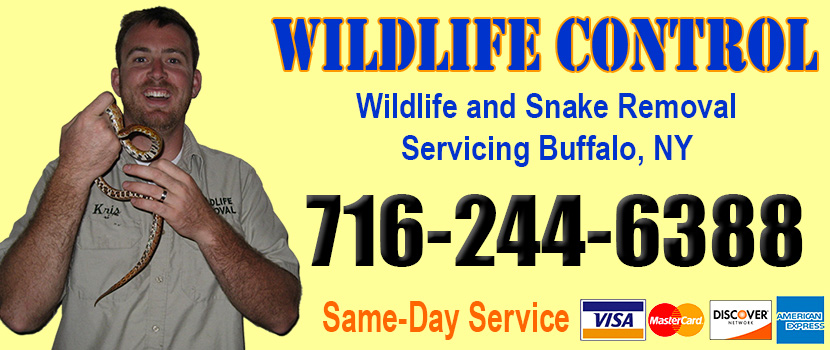
Welcome to buffalosnakes.com! I am David, a snake enthusiast living in Buffalo, NY. Many people don't know that Buffalo is in fact full of snakes! You just need to know where to find them - they can often be shy and elusive. Some New York snake species are more common outside of the city limits, in different parts of Erie County NY, but many types of snakes are indeed common in the more urban parts of Buffalo. This guide is meant to help educate you about the beautiful snakes of Buffalo, and to help you identify the most common snakes of Buffalo, as well as the venomous snakes of Buffalo that you should learn to recognize and avoid. If you want more detail, click here for my complete list of ALL snake species in Buffalo. Remember the following:
- Most snakes of Buffalo are harmless and don't want to encounter you
- Venomous snakes exist but are uncommon in Buffalo, New York
- Snakes eat rats and mice and are a valuable part of the New York ecosystem
- Never kill a snake - if you leave a snake alone, it will leave you alone.
Common Snake Species in Buffalo
 Maritime garter snake:
This is a colorful snake with colors varying from individual to individual. All species, however, tend to have dark green, brown, or black patterns with 3 yellow stripes. One of the stripes runs down the snake’s back and the other two can be found on each of its sides. Adults typically grow less than 1 meter in length. The maritime garter snake is adapted to various habitats and can live anywhere it is opportune to. It can be found in wetlands, fields, shores, forests, and rocky habitats. They can also survive in urban and suburban areas hiding out under logs and rocks. Their diet consists mainly of toads, frogs, earthworms, salamanders, and small fishes. Maritime garter snakes are non-venomous and they pose no threat to humans and pets. They can however bite when threatened or picked up.
Maritime garter snake:
This is a colorful snake with colors varying from individual to individual. All species, however, tend to have dark green, brown, or black patterns with 3 yellow stripes. One of the stripes runs down the snake’s back and the other two can be found on each of its sides. Adults typically grow less than 1 meter in length. The maritime garter snake is adapted to various habitats and can live anywhere it is opportune to. It can be found in wetlands, fields, shores, forests, and rocky habitats. They can also survive in urban and suburban areas hiding out under logs and rocks. Their diet consists mainly of toads, frogs, earthworms, salamanders, and small fishes. Maritime garter snakes are non-venomous and they pose no threat to humans and pets. They can however bite when threatened or picked up. 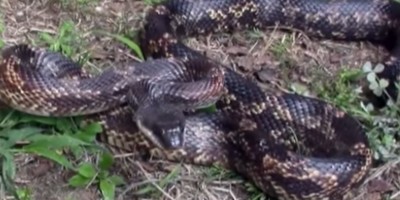 Western rat snake:
The western rat snake is a long snake measuring 42 -72 inches in length. Adult skin is glossy black with occasional brown blotches from the juvenile stage showing. Its lips, chin, and throat are white-colored. Western rat snakes are excellent climbers and can climb vertically up a rough surface. The western rat snake mostly lives in wooded forests, rocky hillsides, or flat farmlands. Their diet consists of small animals such as birds, reptiles, frogs, and sometimes bird eggs. They are often found in chicken coops, eating chicken eggs. This earned them the nickname chicken snakes. This species is a constrictor. It squeezes its prey until it collapses and then swallows it whole. The western rat snake is non-venomous and poses no threat to humans or pets. They can however bite when threatened. It raises and vibrates its tail as well as opens its mouths when warning intruders.
Western rat snake:
The western rat snake is a long snake measuring 42 -72 inches in length. Adult skin is glossy black with occasional brown blotches from the juvenile stage showing. Its lips, chin, and throat are white-colored. Western rat snakes are excellent climbers and can climb vertically up a rough surface. The western rat snake mostly lives in wooded forests, rocky hillsides, or flat farmlands. Their diet consists of small animals such as birds, reptiles, frogs, and sometimes bird eggs. They are often found in chicken coops, eating chicken eggs. This earned them the nickname chicken snakes. This species is a constrictor. It squeezes its prey until it collapses and then swallows it whole. The western rat snake is non-venomous and poses no threat to humans or pets. They can however bite when threatened. It raises and vibrates its tail as well as opens its mouths when warning intruders.
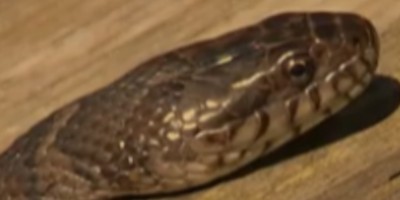 Northern water snake:
The northern water snake is one of the most abundant snakes in the whole of the United States. Adults are typically between 2 and 4.5 feet long with varying shades of brown, grey, buff, or tan. They have dark bands around their bodies which makes them easily confused with venomous snakes, cottonmouths, or copperheads. Northern water snakes live near and around water bodies such as ponds, lakes, canals, marshes, and rivers. They can also be found hiding out in beaver lodges and muskrat houses. Their diets consist mostly of fish and amphibians. These snakes are not constrictors. Rather, they swallow their prey alive. Northern water snakes are non-venomous but they may bite when agitated. They usually flatten their bodies and strike at the intruder.
Northern water snake:
The northern water snake is one of the most abundant snakes in the whole of the United States. Adults are typically between 2 and 4.5 feet long with varying shades of brown, grey, buff, or tan. They have dark bands around their bodies which makes them easily confused with venomous snakes, cottonmouths, or copperheads. Northern water snakes live near and around water bodies such as ponds, lakes, canals, marshes, and rivers. They can also be found hiding out in beaver lodges and muskrat houses. Their diets consist mostly of fish and amphibians. These snakes are not constrictors. Rather, they swallow their prey alive. Northern water snakes are non-venomous but they may bite when agitated. They usually flatten their bodies and strike at the intruder.Venomous Snake Species in Buffalo
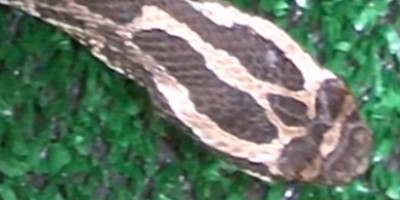 Massasauga rattlesnake:
The Massasauga rattlesnake, also called the pygmy rattlesnake, is a small to medium-sized snake, with adults growing only 60 to 75 centimeters long. It has a triangular head with 3 dark stripes on each side. Its skin is a brown color with darker brown blotches on its sides. Its underside has light markings scattered across it. The scales are rough around the center, giving the snake a rough appearance. It is easily identified by the rattle on its tail, which vibrates when warning off intruders. Massasauga rattlesnakes love to live around water and can be found almost anywhere there is water. They are generally found in shorelines, marshes, grasslands, and wetlands. Its diet consists of mice, rats, small birds, frogs, lizards, and small snakes. It is a pit viper with heat-sensitive pits between its eyes which it uses to sense when there is prey around. Massasauga rattlesnakes are venomous and pose a threat to humans and pets. They however rarely bite unless threatened and they give a warning before striking by rattling their tails at the intruder.
Massasauga rattlesnake:
The Massasauga rattlesnake, also called the pygmy rattlesnake, is a small to medium-sized snake, with adults growing only 60 to 75 centimeters long. It has a triangular head with 3 dark stripes on each side. Its skin is a brown color with darker brown blotches on its sides. Its underside has light markings scattered across it. The scales are rough around the center, giving the snake a rough appearance. It is easily identified by the rattle on its tail, which vibrates when warning off intruders. Massasauga rattlesnakes love to live around water and can be found almost anywhere there is water. They are generally found in shorelines, marshes, grasslands, and wetlands. Its diet consists of mice, rats, small birds, frogs, lizards, and small snakes. It is a pit viper with heat-sensitive pits between its eyes which it uses to sense when there is prey around. Massasauga rattlesnakes are venomous and pose a threat to humans and pets. They however rarely bite unless threatened and they give a warning before striking by rattling their tails at the intruder.
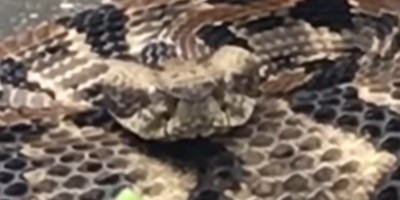 Canebrake rattlesnake:
Also known as the timber rattlesnake, the canebrake rattlesnake is a heavy-bodied snake measuring on average 36 to 60 inches in length. The color of its skin is usually black or greyish to yellowish pink. In adults, there are crossbands arranged down the length of the body. Canebrake rattlesnakes typically live in lowlands and hillsides, usually habiting hardwood forests, cane thickets, and pine flatwoods. They mostly eat mice and squirrels, although they may occasionally eat birds and frogs. Like all snakes in the pit viper family, the canebrake rattlesnake is venomous and a bite poses a threat to humans and pets. Bites from canebrake rattlesnakes are, however, not common as they are not aggressive. They will rattle their tails when disturbed in an attempt to warn intruders before they strike.
Canebrake rattlesnake:
Also known as the timber rattlesnake, the canebrake rattlesnake is a heavy-bodied snake measuring on average 36 to 60 inches in length. The color of its skin is usually black or greyish to yellowish pink. In adults, there are crossbands arranged down the length of the body. Canebrake rattlesnakes typically live in lowlands and hillsides, usually habiting hardwood forests, cane thickets, and pine flatwoods. They mostly eat mice and squirrels, although they may occasionally eat birds and frogs. Like all snakes in the pit viper family, the canebrake rattlesnake is venomous and a bite poses a threat to humans and pets. Bites from canebrake rattlesnakes are, however, not common as they are not aggressive. They will rattle their tails when disturbed in an attempt to warn intruders before they strike.
If you're unsure, you can email me a photo of the snake at info@buffalosnakes.com and I will email you back with the snake's species. If you found a snake skin, read my Found a Skin? page, and you can email me a photo of the skin, and I'll identify the snake for you. If you need professional Buffalo snake removal help, click my Get Help page, or see the below website sponsor I found, who provides that service.
Remember, the term is not poisonous snakes of Buffalo, it's venomous snakes of Buffalo. Poison is generally something you eat, and venom is injected into you. That said, dangerous snakes are very rare in Buffalo. The few venomous snakes of Erie County are rarely seen. But they are commonly misidentified, so learn about all the snake species of Buffalo in order to correctly identify them. These snakes are usually also found in the surrounding towns of Amherst, Hamburg, Cheektowaga, Williamsville, West Seneca, Orchard Park, Lancaster, East Aurora, Tonawanda, Grand Island, Clarence, Alden, Springville, Akron, Depew, Kenmore, Lackawanna, Blasdell, Marilla, Angola, Eden, East Amherst, North Collins, Colden, Hollan, Boston, Collins, Brant, Clarence Center, Sardini, Eggertsville, Snyder, Lake Erie Beach, Sloan, Angola on the Lake, and the surrounding areas.
Read our article about:
A Complete Guide on Trapping the Snake
buffalosnakes.com domain and hosting costs made possible by the generous support of this sponsor:
